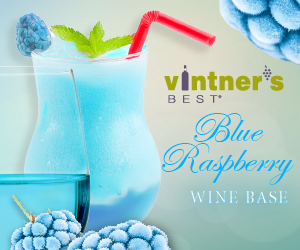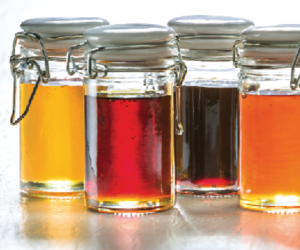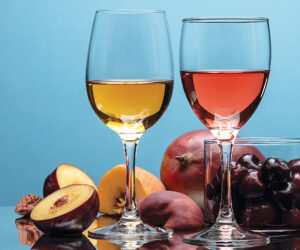 Is there a beverage that conjures up more images than mead? Whether you associate it with Druids, pre-Roman civilizations of central Europe, Vikings and Teutonic raiders, Celts ancient or modern, it is impossible to deny the hold that mead has always had on the imagination of Western civilization.
Is there a beverage that conjures up more images than mead? Whether you associate it with Druids, pre-Roman civilizations of central Europe, Vikings and Teutonic raiders, Celts ancient or modern, it is impossible to deny the hold that mead has always had on the imagination of Western civilization.
It probably was mead that Homer and others had in mind when they described “nectar,” favored beverage of the inhabitants of Olympus. Certainly mead played a role in the Icelandic sagas, in Beowulf, in the writings of the ancient Irish bards. It is mentioned in the Bible, in African tribal lore, even in the epic of Gilgamesh. Wherever man has lived, he has made mead, even in lands where the grape or grain grew in abundance.
But what is mead? In general terms mead is wine made from honey. But there generality ends. Every region or people who has produced mead has given it a different, customized spin. One need only look at the varieties of mead in the northwestern European tradition to begin to see that diversity.
There are still meads and sparkling meads, strong meads and small meads, dry meads and sweet meads. Spiced mead (metheglin, from which the English word “medicine” comes), fruited mead (melomel), mead mixed with grape wine (pyment) or with apple juice (cyser), even a blend of mead and beer known in Old and New England as “bracken,” the peoples of the Celtic/Anglo-Saxon world knew them all.
The home wine- and beer-making resurgence of recent years has also helped mead be rediscovered. In fact mead is often the first wine homebrewers try to make and the first brew that home winemakers attempt. Meadmaking follows many of the same basic rules and procedures as brewing beer from extract syrup, but the aging and conditioning is more like winemaking. The major difference is time, both in the brewing and the fermentation. Above all, making mead requires a considerable amount of patience. Be warned that it will be several months (if not years) before your efforts will be rewarded, and there is really no way to speed it up.
The four mead-making steps:
- Brewing, in which a quantity of honey is diluted in water (either just hot enough to dissolve the honey but not boiling or actually boiled for up to 15 minutes or so).
- Fermenting with a beer or wine yeast (or a specialized mead yeast, if one is available) in a similar, preferably closed, fermentation vessel to that used for wine or beer.
- Aging, which may occur in bulk or in the bottle, depending on the meadmaker’s capacity for storage, and which is the single most important influence on the flavor of the mead.
- Packaging, where the meadmaker must choose between cask and bottle, between priming for a sparkling product and bottling as for a still beverage.
The addition of fruit or spice may occur in almost any of these steps: in the kettle, in the primary fermenter, in an aging vessel, or at bottling.
Making Mead
Here is a basic step-by-step procedure. The included recipes all follow these instructions, and you can use these steps as a guideline when you are ready to create your own recipe.
- Bring water to a boil, add water treatments (usually gypsum and acid blend) and honey. Boil no more than 15 minutes, skimming the foamy albumen off the surface every two or three minutes.
- Chill to 75° F (24° C) and add yeast nutrients, stir to dissolve, and then pitch yeast. Seal and put it in a relatively cool (65° to 70° F, 18° to 21° C) corner.
- Ferment 10 to 14 days in primary, then rack to a glass secondary. Age in secondary for at least six weeks. (Check the airlocks regularly to avoid evaporation and contamination problems!)
- Bottle (when gravity has fallen below 1.020 or so), either as is or priming with 1/8 cup (30 mL) of corn sugar per gallon (3.8 L) for sparkling mead. If you are bottling in beer bottles, the use of oxygen-absorbing caps is strongly recommended.
- Leave the bottled mead undisturbed in a cool, dark place for three months before you even think about trying one. The first bottle you taste will probably disappoint you. Leave the mead alone for another three months, then try it again. Bottled sparkling mead casts a considerable amount of sediment, so decant carefully when serving.
Choosing Ingredients
The most important ingredient, of course, is honey. The fresher and less treated the honey you can find, the better flavor and aroma you will get. Unpasteurized, unfiltered, and without preservatives is best. Beyond that, however, there isn’t any single honey that meadmakers agree is better than another.
Meadmakers use local wildflower honey, clover honey, orange-blossom honey from Florida, blueberry honey from Maine, and each contributes its own unique flavor profile. Some meadmakers use mesquite honey, which produces a very unique mead. The color of the honey will have some effect on the color of the mead, but aging usually lightens even the darkest mead considerably.
When it comes to treating the water, some meadmakers prefer it more acidic with more sulfate, which seems to balance the inherent sweetness of the honey and retain the aroma better than more alkaline or carbonate water. Try adding a teaspoon (5 mL) each of gypsum (calcium sulfate) and some form of winemaker’s acid, either citric or a citric/malic/tartaric blend. Experiment, especially since your water is unique to your area.
With the amount of fermentables involved in making mead, sometimes two to three pounds (0.9 to 1.35 kg) of honey per gallon (3.8 L), it is important to boost the yeast by adding a nutrient of some kind. Any of the commercial yeast energizers will work fine, and they are best added along with the yeast.
It is also important to pitch an adequate yeast culture, at least 10 to 14 grams of dry yeast or a pint or more of a liquid slurry, in five gallons (18.9 L) or less. Mead can be made using beer yeast, both ale and lager; wine yeast; Champagne yeast; or custom-cultured mead yeast. Wyeast even sells two different liquid cultures, one with a higher alcohol tolerance (hence for drier mead) and one with a lower tolerance, leaving a sweeter finish.
In an attempt to boost the alcoholic strength of the mead, some meadmakers add other sugars (molasses, cane, or corn sugar, and so forth), but this is not entirely authentic.
Additions of sugars such as maple sap or syrup can be used for the flavor more than for the fermentables. If tradition and authenticity do not play a major role in your winemaking, then by all means go ahead and experiment. Any sugars other than honey might, in fact, speed up fermentation, but they might also contribute undesirable harsh flavors as well.
Recipes
With the exception of the cyser, the following recipes are all for three gallons (11.4 L), which is a good batch size, due in part to the cost of honey. Unless otherwise noted, follow the above step-by-step directions.
Still of the Night Mead
A light, still straight mead, similar to a sweet white wine. This is perfect as an aperitif or with dessert.
Ingredients:
- 1/2 tsp. (2.5 mL) acid blend
- 1/2 tsp. (2.5 mL) gypsum
- 5 lbs. (2.25 kg) honey (clover or wildflower)
- 1/2 tsp. (2.5 mL) Fermax or other yeast nutrient
- Yeast
Step by Step:
Treat 3 gal. (11.4 L) water with acid blend and gypsum, then boil. Add honey and boil 15 min. Chill and add Fermax or other yeast nutrient. Pitch yeast and ferment.
Age at least three months before bottling; do not prime.
This mead should age for six to eight months before being served.
Sparkling Cyser
A thirst-quenching but deceptively strong sparkling brew. Darker than most, because of the cider. Serve chilled.
Ingredients:
- 1/2 tsp. (2.5 mL) acid blend
- 1/2 tsp. (2.5 mL) gypsum
- 5 lbs. (2.25 kg) honey (clover or wildflower)
- 2 gal. (7.6 L) fresh apple cider
- 1/2 tsp. (2.5 mL) Fermax or other yeast nutrient
- Yeast
- 2/3 cup (160 mL) corn sugar for priming
- 5 g fresh dry Champagne or lager yeast at bottling
Step by Step:
Follow the same ingredients and procedure as Still of the Night, except stretch it to 5 gal. (18.9 L) by adding fresh apple cider to the cooled must, as you pitch the yeast.
Age three to four months and bottle, priming with corn sugar and fresh dry Champagne or lager yeast. Age cool for four to six months.
Kiwi-Strawberry Melomel
A great substitute for dry Champagne. Has been part of many a special celebration!
Ingredients:
- 6.5 lbs. (2.9 kg) light honey (clover is best here)
- 1/2 tsp. (2.5 mL) gypsum
- 1 tsp. (5 mL) citric acid
- Prise de mousse yeast
- 2 lbs. (0.9 kg) fresh bruised strawberries
- 5 or 6 peeled and mashed kiwis
- 3/8 cup (90 mL) of corn sugar for priming
Step by Step:
Boil honey, gypsum, and citric acid in 3 gal. (11.4 L) of water. Then chill and pitch prise de mousse yeast.
After 10 to 14 days, rack onto fresh bruised strawberries and peeled and mashed kiwis. Age on fruit three to four weeks, and rack into a third fermenter. Condition six to eight weeks, prime with corn sugar and bottle in Champagne bottles. Age cool for up to a year.
Saint Valentine’s Metheglin
Beware of the reputed aphrodisiac effects of the cinnamon! Serve warm, even slightly “mulled,” on a cold February night.
Ingredients:
- 1/2 tsp. (2.5 mL) acid blend
- 1/2 tsp. (2.5 mL) gypsum
- 5 lbs. (2.25 kg) honey (clover or wildflower)
- 1/2 tsp. (2.5 mL) Fermax or other yeast nutrient
- Yeast
- 4 to 6 crushed cinnamon sticks
- 1 chopped vanilla bean
- 1/3 cup (80 mL) corn sugar to prime
Step by Step:
Follow the directions for Still of the Night, but when you rack to your secondary put in crushed cinnamon sticks and vanilla bean (in a muslin bag, preferably). Condition with the spices for four to six weeks, then rerack. Age six more weeks, then bottle, priming with corn sugar. If you wish, you can put a candy cinnamon heart in each bottle.
Old/New England Bracken
An old recipe, perhaps originally the result of thrifty beer brewers wanting to make a less expensive mead, since malt would certainly have cost less than honey for most people! It’s malty like a Munich Helles Lager, big and powerful like a Belgian Tripel Ale, but it’s also still a wine.
Ingredients:
- 1/2 tsp. (2.5 mL) of gypsum
- 3 lbs. (1.4 kg) of extra-light dry malt extract
- 4 lbs. (1.8 kg) honey
- 1/2 tsp. (2.5 mL) yeast nutrient
- A substantial yeast slurry (perhaps a blend of a neutral ale yeast and a white wine yeast).
- 1/3 cup (80 mL) of corn sugar for priming
Step by Step:
In three gallons of water, treated with gypsum, boil extra-light dry malt extract (available at a homebrewing supply stores) for 30 min. Add honey (here’s a good place to experiment with honey, perhaps blackberry, mesquite, or star thistle) and boil 15 min. more. Chill, add yeast nutrient, and pitch slurry.
Ferment 14 days at 70° F (21° C), then 10 more at 60° F (16° C), then rack to secondary. Age 10 to 12 weeks, then bottle, priming with corn sugar. Bottle condition for at least 10 months.







